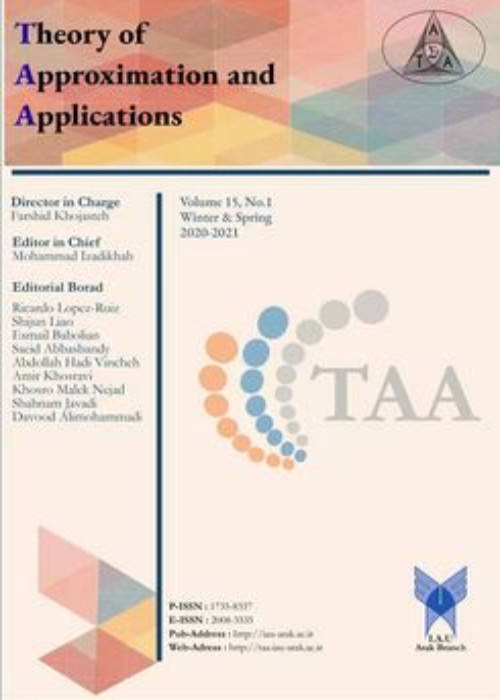فهرست مطالب
Theory of Approximation and Applications
Volume:16 Issue: 1, Winter and Spring 2022
- تاریخ انتشار: 1401/02/11
- تعداد عناوین: 10
-
Pages 1-7
In this paper we prove existence of fixed point theorems for Z-contractive map, Geraghty type contractive map and interpolative Hardy-Rogers type contractive mapping in the setting of SJS- metric spaces with two metrics. Examples are constructed to high light the significance of newly obtained results.
Keywords: S^{JS}- metric space, fixed point, Z-contractive map, Geraghty type contractive map, interpolative Hardy-Rogers type contractive map -
Pages 8-13
Stochastic differential equations (SDEs) have been applied by engineers and economists because it can express the behavior of stochastic processes in compact expressions. In this paper, by using Grunwald-Letnikov fractional derivative, the stochastic differential model is improved. Two numerical examples are presented to show efficiency of the proposed model. A numerical optimization approach based on least square approximation is applied to determine the order of the fractional derivative. Numerical examples show that the proposed model works better than the SDE to model stochastic processes with memory.
Keywords: fractional derivative, Grunwald-Letnikov fractional derivative, Stochastic differential model, Stochastic process with memory -
Pages 14-20
In this paper, we introduce a cone generalized semi-cyclicφ−contraction maps and prove best proximity points theorems for such mapsin cone metric spaces. Also, we study existence and convergence results ofbest proximity points of such maps in normal cone metric spaces. Our resultsgeneralize some results on the topic.
Keywords: Best proximity points, Cone metric spaces, Normal cone metric spaces, Cone generalized semi-cyclic φ-contraction maps -
Pages 21-32
In thise paper we study an special type of Cyclic Codes called skewCyclic codes over the ring R=Fp[v]/(v^2^k-1) where is a prime number. This setsOf codes are the result of module (or ring) structure of the skew polynomial ringR=[x,Q] where v^2^k=1 and Q is an Fp automorphism such that Q(v)=v^2^k-1.We show that when n is even these codes are principal and if n is odd these codeLook like a module and proof some properties.
Keywords: skew cyclic code, Ring, code over ring -
Pages 33-40
In this paper, we characterize symmetric Hadamard spaces by the help of new midpoint propertiesin these spaces and show that any symmetric Hadamard spaces are flat. As an application of the newmidpoint property we characterize the affine mapping in these spaces.
Keywords: CAT(0) spaces, Hadamard space, Quasi linearization, Affine maps, Midpoint -
Pages 41-50
Wang et al. (2005) proposed a pair of data envelopment analysis (DEA) models to deal with the efficiency assessment of decision-making units (DMU) in the presence of interval input/output data. Their approach was developed with reference to an earlier approach proposed by Despotis and Smirlis (2002) for the same problem. Given that the input/output data are given as interval numbers, the efficiency scores are interval measures as well. In such a setting, both approaches provide lower and upper bounds for the efficiency scores. Wang et al. (2005) claim that the lower and upper bounds calculated in Despotis and Smirlis (2002) are incorrect. Then, they present different models to calculate the true bounds. In this paper, we counter-argue their claim and we show that the Despotis and Smirlis bounds are correct and those provided in Wang et al. are estimated in a manner that they fail to satisfy an obvious property that they should possess. We illustrate our arguments with a counterexample that was originally used in Wang et. al (2005).
Keywords: Data envelopment analysis, Interval data, interval efficiency -
Pages 51-58
In recent years many numerical methods have proposed for solving linear integral equations. In this paper we propose the finite differences method for solving linear and nonlinear Fredholm integral equations of the second kind with arbitrary kernel and present some examples to illustrate this method.
Keywords: Finite differences, interpolation, integral equations, numerical method -
Pages 59-72
In this paper, Runge-Kutta (RK) methods is introduced; The conditions of order p and its equations have been investigated by calculating Fréchet derivatives and displaying them graphically as rooted trees. The concept of effective order and combination of methods are introduced; The efficiency of the effective order method is explicitly compared to the RK method with the classical order in terms of computational speed and reduction of the number of ancient conditions.
Keywords: Order, Effective order, Runge-Kutta Methods, Combination of methods -
Pages 73-80
In this article, we apply this new method for solving an engineering system withinitial and boundary conditions and integral criterion, and we will use dynamicprogramming as iteration for solving model.
Keywords: Optimal Control, Radon measure, Engineering system, Iteration Method, Trajectory -
Pages 81-91
Fuzzy integral equations play a fundamental role in the many fields of engineering and applied mathematics. The paper presented, a new type of fuzzy Volterra integral equations of the second kind with nonlinear fuzzy kernels. Numerical solutions of a new type of nonlinear fuzzy Volterra integral equations with nonlinear fuzzy kernels through Variational Homotopy perturbation (VHP) method based on the parametric form of a fuzzy number, is investigated. To find the approximate solution and to get an approximation for fuzzy solution of the new type of nonlinear fuzzy Volterra integral equations the VHPM is applied, and it is shown that VHPM is an effective and reliable approach to solve these equations. Finally, a few numerical examples are given and results unfold that VHPM is very close to exact solutions. The obtained approximate solutions are contrasted with the exact solution, and absolute error between obtaining numerical results and an exact solution are found. One of the examples shows a comparison between VHPM and HPM.
Keywords: Variational Homotopy perturbation method, Fuzzy Volterra integral equation, Nonlinear fuzzy kernels


